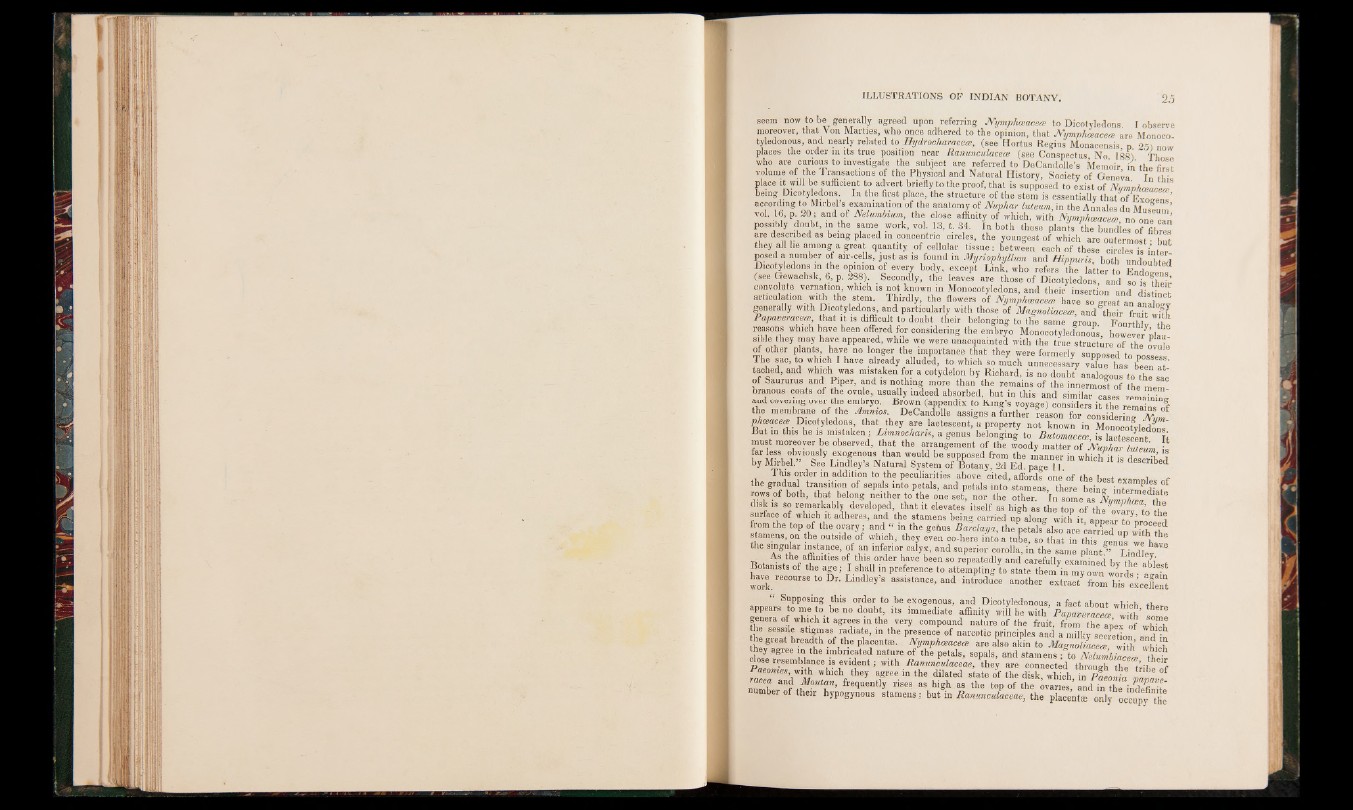
s»”'*“11; »given upou reierring jyympnceacea! to Dicotyledons I observe
moreover, that Von Marties, who once adhered to the opinion, that JYymphceacece are Monoco-
tyledonous, and nearly related to Hydrocharacece, (see Hortus Regius Monacensis n 211 now
places the order in its true position near Ranunculaeece (see Conspectus No 1881 Th
who are curious to investigate the subject are referred to DeCandolle’s Memoir in the first
volume of the Transactions of the Physical and Natural History, Society of Geneva In this
place it will be sufficient to advert briefly to the proof, that is supposed to exist of Nymvhoeacecr
being Dicotyledons In the first place, the structure of the stem is essentially that of Exo“ ens
according to Mirbel s examination of the anatomy of Nuphar luteum, in the Annales du Museum
■ m pj 20A and,?f H H i thfi close of which, with Nymphceacece, no one ™
possibly doubt, in the same work, vol. 13, t. 34. In both these plants the bundles of fibres
are described as being placed in concentric circles, the youngest of which are outermost hut
they all he among a great quantity of cellular tissue: between each of these circles is in
posedanumberof air-cells, just as is found in Myriophyllum and Hippuris, both undoubted
Dicotyledons m the opinion of every body, except Link, who refers the latter to Endogens
(see Gewachsk, 6, p. 288) Secondly, the leaves are those of Dicotyledons, and so is t S
convolute vernation, which is noj known m Monocotyledons, and their insertion and distin J
articulation with the stem. Thirdly, the flowers of g M g H I have so great an a t . ogv
generally with Dicotyledons, and particularly with those of Mnsnoliacece, and their fruit S
Papaverace«: that it is difficult to doubt their belonging to g l same group. X r hly the
reasons which have been offered for considering the embryo Monocotyledonous, however ffiau
sible they may have appeared, wh, e we were unacquainted with the true structure of the ovule
of other plants, have no longer the important*, that they were formerly supposed to possess
The sac, to which I have already alluded, to,which so much unnecessary value has been at
tached, and which was mistaken for a cotydelon by Richard, is no doubt analogous to the sac
of Saururus and Piper, and is nothing more, than the remains of the innermost of he mem
branous coats of the ovule, usually indeed absorbed, but in this and similar cases remaTning
and covering over the embryo. Brown (append x to King’s vovagel considers it tl,» BS J n,nS
the membrane of the Amnios DeCanJSle assigns a
phoeace«! Dicotyledons, that they are lactescent, a property not known in Monocotyledons
But in this he is mistaken ; Limnocharu, a genus belonging to Butomacecc, is lactescent D
must moreover be observed, that the arrangement of the woody matter of Wuphav lZ u m is
far less obviously exogenous than would be supposed.from the manner in which it is deserTw
by Mirbel.” See Lindley’s Natural System of Botany, 2d Ed. page 11 described
This qrder m addition to the peculiarities above cited, affords one of the best examnlcs
the gradua transition of sepals into petals, and petals into stamens, there being intermeffiaf
rows of both, that belong neither to the one set, nor the other In some „ At,,™ l mea*fte
disk is so remarkably developed, that it elevates itself as high as the toD of the y™pha>a; t.*?e
surface of which it adheres, and the stamens being carried up§ along w t h ^ f appear to X ° ,
from the top of the ovary; and S in the gehus Barclaya, t h e p e t a l s ^ ! ™ S JES.'7 ^
i f f l ,oa ^ e outside of which; they even co-here into a tube, so that in this genus we have
the singular instance, of an inferior calyx, and superior corolla, in the same plant® Lindley
As the affinities of this order have been so repeatedly and carefully examined hv rtT„Tm
Botanists of the age; I shall in preference to attempting to state them ffi my ^wn words 1
have recourse to Dr. Lmdley’s assistance, and introduce another extract from h istc ellen “
Supposing this order to be exogenous, and Dicotyledonous, a fact about which eh
appears to me to be no doubt, its immediate affinity will be w ith Palave r™! ‘here
genera of which it agrees in the very compound nature of the fruit, from the apex of X v h
the sessile stigmas radiate, m the presence of narcotic principles and a milky secretion I s *
he great breadth of the placentae. Nymphceacece are also akin to Magnohacece with which
they agree m the imbricated nature of the petals, sepals, and stamens ; to NelumbiacL thX
dose resemblance is evident; with Ranunculaceae, they are connected through the Vc
Paeomes with which they agree in the dilated state of the d“ k whlh i T J w « 2 ^
racea and Moutan, frequently rises as high as the top of the ovaries ’ and in the ind' f l T
number of their hypogynous stamens; but in Ranunculaceae, the placent^onl^occupy “the